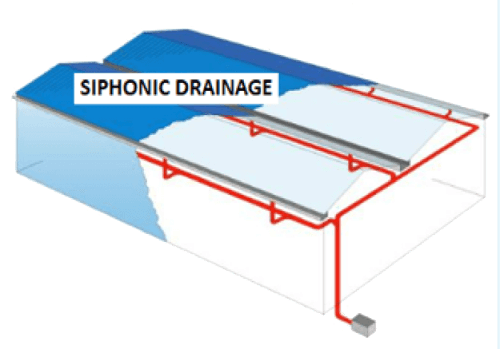Siphonic drainage is a modern solution that addresses the limitations of traditional drainage systems. It uses full-bore flow and negative pressure principles to drain water more efficiently.
Instead of relying on gravity, siphonic drainage relies on a closed system that creates a siphon effect, allowing water to be drained quickly and in large volumes.
So, what are the advantages of siphonic drainage? Here’s a closer look.
Increased Drainage Efficiency
One of the main advantages of siphonic drainage is greater efficiency.
These systems use a full-bore flow mechanism, which means that the pipes are completely filled with water during operation.
The full-bore flow significantly increases the speed and volume of water drainage compared to traditional systems. As a result, there is a notable reduction in water level build-up on rooftops and other surfaces, helping mitigate the risk of water damage and structural stress during heavy rainfall.

Cost-Effective Installation and Maintenance
Siphonic drainage systems are also more cost-effective. The need for smaller pipe diameters and fewer materials reduces overall material costs.
Installation costs are also lower, as these systems require fewer roof penetrations and less extensive pipework. This streamlined installation process translated to reduced labour and time expenses.
Thanks to the straightforward pipe layouts and improved accessibility, maintenance is also easier, helping to ensure long-term savings and ease of upkeep.
Space-Saving Design
The compact design of a siphonic system makes it a top choice for urban environments. These systems require less vertical space compared to traditional drainage systems. This compactness also provides architectural flexibility, enabling more creative and aesthetic building designs. Additionally, Syphonic systems have no fall and are installed totally horizontal
Architects can optimise the interior layouts without compromising on drainage efficiency. This helps lead to a more innovative and functional structure.
Environmental Benefits
Siphonic drainage systems can contribute to environmental sustainability in several ways. First, they can be seamlessly integrated with rainwater harvesting systems, promoting water reuse for various purposes, such as irrigation and non-potable uses.
It also reduces the demand for fresh water and supports water conservation efforts. Additionally, siphonic systems help reduce stormwater runoff, decreasing the burden on municipal sewer systems and local waterways.
By reducing the risk of flooding and erosion, these systems contribute to a healthier urban environment.
Improved Safety and Reliability
Safety and reliability are important features in drainage system design. Siphonic systems excel in these areas, as the risk of overflow and leakage is significantly reduced compared to traditional systems.
Siphonic drainage can easily handle heavy rainfall, ensuring reliable performance under extreme weather conditions. This reliability enhances the safety of buildings and their occupants, providing peace of mind for property owners and managers.
Conclusion
Siphonic drainage systems offer many advantages over traditional drainage methods, including increased efficiency, cost-effectiveness, space-saving design, environmental benefits, and improved safety and reliability.
Efficient and sustainable drainage solutions are becoming increasingly critical, especially in urban areas.
Where can I go for further information?
Check out our quick guide to siphonic drainage for more on how siphonic drainage works, the key benefits, and critical calculations to ensure your system is fit for purpose.

